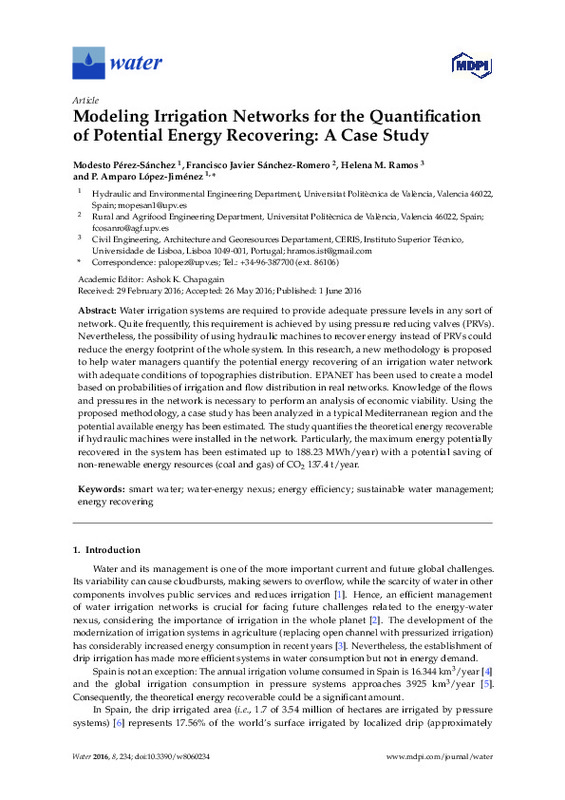JavaScript is disabled for your browser. Some features of this site may not work without it.
Buscar en RiuNet
Listar
Mi cuenta
Estadísticas
Ayuda RiuNet
Admin. UPV
Modeling irrigation networks for the quantification of potential energy recovering: a case study
Mostrar el registro sencillo del ítem
Ficheros en el ítem
| dc.contributor.author | Pérez-Sánchez, Modesto
|
es_ES |
| dc.contributor.author | Sánchez-Romero, Francisco-Javier
|
es_ES |
| dc.contributor.author | Ramos, Helena M.
|
es_ES |
| dc.contributor.author | López Jiménez, Petra Amparo
|
es_ES |
| dc.date.accessioned | 2016-09-13T11:00:05Z | |
| dc.date.available | 2016-09-13T11:00:05Z | |
| dc.date.issued | 2016-06 | |
| dc.identifier.issn | 2073-4441 | |
| dc.identifier.uri | http://hdl.handle.net/10251/69337 | |
| dc.description.abstract | Water irrigation systems are required to provide adequate pressure levels in any sort of network. Quite frequently, this requirement is achieved by using pressure reducing valves (PRVs). Nevertheless, the possibility of using hydraulic machines to recover energy instead of PRVs could reduce the energy footprint of the whole system. In this research, a new methodology is proposed to help water managers quantify the potential energy recovering of an irrigation water network with adequate conditions of topographies distribution. EPANET has been used to create a model based on probabilities of irrigation and flow distribution in real networks. Knowledge of the flows and pressures in the network is necessary to perform an analysis of economic viability. Using the proposed methodology, a case study has been analyzed in a typical Mediterranean region and the potential available energy has been estimated. The study quantifies the theoretical energy recoverable if hydraulic machines were installed in the network. Particularly, the maximum energy potentially recovered in the system has been estimated up to 188.23 MWh/year) with a potential saving of non-renewable energy resources (coal and gas) of CO2 137.4 t/year. | es_ES |
| dc.language | Inglés | es_ES |
| dc.publisher | MDPI | es_ES |
| dc.relation.ispartof | Water | es_ES |
| dc.rights | Reconocimiento (by) | es_ES |
| dc.subject | Smart water | es_ES |
| dc.subject | Water-energy nexus | es_ES |
| dc.subject | Energy efficiency | es_ES |
| dc.subject | Sustainable water management | es_ES |
| dc.subject | Energy recovering | es_ES |
| dc.subject.classification | MECANICA DE FLUIDOS | es_ES |
| dc.subject.classification | INGENIERIA AGROFORESTAL | es_ES |
| dc.subject.classification | INGENIERIA HIDRAULICA | es_ES |
| dc.title | Modeling irrigation networks for the quantification of potential energy recovering: a case study | es_ES |
| dc.type | Artículo | es_ES |
| dc.identifier.doi | 10.3390/w8060234 | |
| dc.rights.accessRights | Abierto | es_ES |
| dc.contributor.affiliation | Universitat Politècnica de València. Escuela Técnica Superior de Ingenieros Industriales - Escola Tècnica Superior d'Enginyers Industrials | es_ES |
| dc.contributor.affiliation | Universitat Politècnica de València. Escuela Técnica Superior de Ingeniería Agronómica y del Medio Natural - Escola Tècnica Superior d'Enginyeria Agronòmica i del Medi Natural | es_ES |
| dc.contributor.affiliation | Universitat Politècnica de València. Escuela Politécnica Superior de Alcoy - Escola Politècnica Superior d'Alcoi | es_ES |
| dc.description.bibliographicCitation | Pérez-Sánchez, M.; Sánchez-Romero, F.; Ramos, HM.; López Jiménez, PA. (2016). Modeling irrigation networks for the quantification of potential energy recovering: a case study. Water. 8(6):1-26. doi:10.3390/w8060234 | es_ES |
| dc.description.accrualMethod | S | es_ES |
| dc.relation.publisherversion | http://dx.doi.org/10.3390/w8060234 | es_ES |
| dc.description.upvformatpinicio | 1 | es_ES |
| dc.description.upvformatpfin | 26 | es_ES |
| dc.type.version | info:eu-repo/semantics/publishedVersion | es_ES |
| dc.description.volume | 8 | es_ES |
| dc.description.issue | 6 | es_ES |
| dc.relation.senia | 313163 | es_ES |








